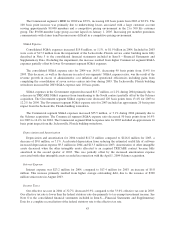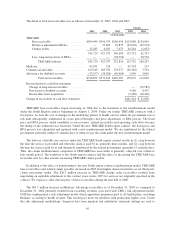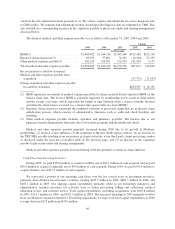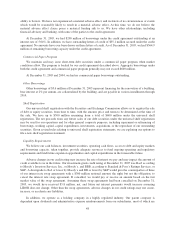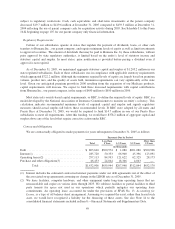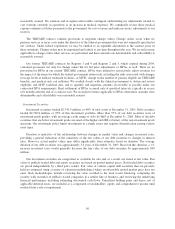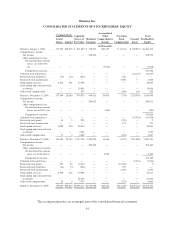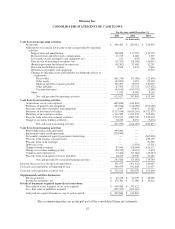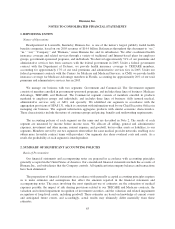Humana 2005 Annual Report Download - page 63
Download and view the complete annual report
Please find page 63 of the 2005 Humana annual report below. You can navigate through the pages in the report by either clicking on the pages listed below, or by using the keyword search tool below to find specific information within the annual report.
The completion and claims per member per month trend factors are the most significant factors impacting
the IBNR estimate. The following table illustrates the sensitivity of these factors and the estimated potential
impact on our operating results caused by changes in these factors based on December 31, 2005 data:
Completion Factor(a): Claims Trend Factor(b):
(Decrease)
Increase
in Factor
Increase
(Decrease) in
Medical and
Other Expenses
Payable
(Decrease)
Increase
in Factor
(Decrease)
Increase in
Medical and
Other Expenses
Payable
(dollars in thousands)
(3%) $ 183,000 (3%) $(68,000)
(2%) $ 117,000 (2%) $(44,000)
(1%) $ 56,000 (1%) $(21,000)
1% $ (53,000) 1% $ 26,000
2% $(102,000) 2% $ 49,000
3% $(150,000) 3% $ 73,000
(a) Reflects estimated potential changes in medical and other expenses payable caused by changes in
completion factors for incurred months prior to the most recent three months.
(b) Reflects estimated potential changes in medical and other expenses payable caused by changes in
annualized claims trend used for the estimation of per member per month incurred claims for the most
recent three months.
Most medical claims are paid within a few months of the member receiving service from a physician or
other health care provider. As a result, these liabilities generally are described as having a “short-tail”, which
causes less than 2% of our medical and other expenses payable as of the end of any given period to be
outstanding for more than 12 months. As such, we expect that substantially all of the December 31, 2005
estimate of medical and other expenses payable will be known and paid during 2006.
Our reserving practice is to consistently recognize the actuarial best point estimate within a level of
confidence required by actuarial standards. Actuarial standards of practice generally require a level of confidence
such that the liabilities established for IBNR have a greater probability of being adequate versus being
insufficient, or such that the liabilities established for IBNR are sufficient to cover obligations under an
assumption of moderately adverse conditions. Adverse conditions are situations in which the actual claims are
expected to be higher than the otherwise estimated value of such claims at the time of the estimate. Therefore, in
many situations, the claim amounts ultimately settled will be less than the estimate that satisfies the actuarial
standards of practice.
IBNR established in connection with our TRICARE contracts is typically more difficult to estimate than for
our other operations, because there are more variables that impact the estimate. These additional variables
include continual changes in the number of eligible beneficiaries, changes in the utilization of military treatment
facilities and changes in levels of benefits versus the original contract provisions. Many of these variables are
impacted by an increase or decrease in military activity involving the United States armed forces. We have
considered all of these factors in establishing our IBNR estimate. Each of these factors requires significant
judgment by management.
As more fully described on page 55, our TRICARE contract contains risk-sharing provisions with the
Department of Defense and with subcontractors, which effectively limit profits and losses when actual claim
experience varies from the targeted medical claim amount negotiated in our annual bid. As a result of these
contract provisions, the impact of changes in estimates for prior year TRICARE medical claims payable on our
results of operations is reduced substantially, whether positive or negative.
As more fully described on pages 11 and 12, we have a significant percentage of our Medicare and
Medicaid membership under risk-sharing arrangements with providers. Accordingly, the impact of changes in
53


